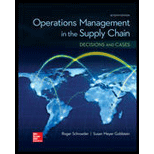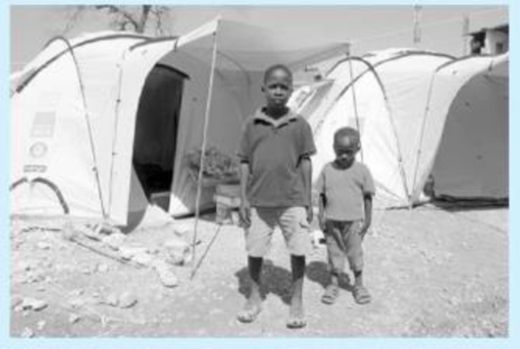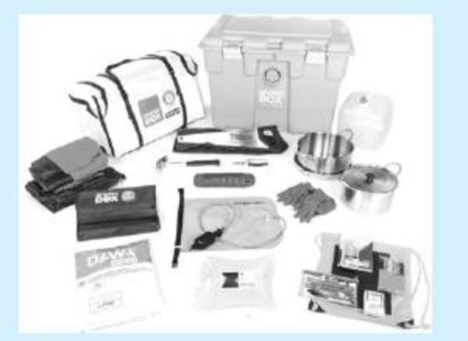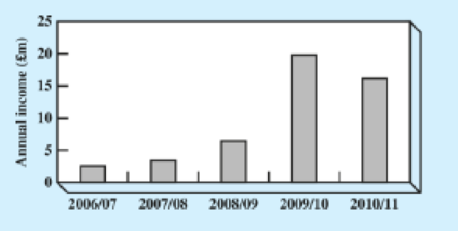
Concept explainers
Shelterbox: A Decade of Disaster Relief
Shelter BOX
In the aftermath of the Haiti earthquake in 2010, UK-based disaster relief charity ShelterBox deployed the largest response in the organisation’s ten-year history. The charity’s mission, “to rapidly provide emergency shelter and vital aid to stabilise, protect and support communities overwhelmed by disaster and humanitarian crisis,” is met by a global team of volunteers, affiliates and staff.
Initially, a local Rotary club millennium project, ShelterBox has been able to utilise the global network of Rotary clubs to meet the ever-increasing need for humanitarian assistance.
However, the journey from local project to global humanitarian provider has been anything but straightforward and episodes of incremental growth have been met with numerous complex strategic and operational challenges.
HAITI EARTHQUAKE, 2010
At 16.53 on January 12, 2010, a 7.0-magnitude earthquake struck beneath the Caribbean nation of Haiti. The epicenter was situated near Léogâne, 25 kilometers southwest of the capital city Port-au-Prince. The earthquake caused extensive and catastrophic damage to the entire area including many of the capital’s principal buildings, residences and commercial properties. Figures released by the International Committee of the Red Cross (ICRC) and the Disasters Emergency Committee (DEC), stated that 180,000 homes were destroyed, 230,000 people were killed, a further 300,000 people were injured, and a population of half-a- million people was displaced. The earthquake lasted 40 seconds.
Twelve minutes after the earthquake struck, UK-based international disaster relief charity ShelterBox initiated their response to the disaster and 900 boxes of aid were quickly dispatched. The scale of the situation quickly became apparent to the aid agencies and military representatives on the ground. ShelterBox realized this would become the greatest test facing the charity so far, surpassing the response required in the aftermath of the Asian tsunami, which struck on Boxing Day, 2004.
Once ShelterBox had mobilized all of its available resources a dedicated fundraising campaign for Haiti was initiated and in the twelve months following the earthquake the charity's income doubled to £16.2 million. A total of 28,417 ShelterBoxes were delivered providing emergency shelter and survival equipment for more than a quarter of a million internally displaced people (IDPs).

Two young boys in a ShelterBox camp near Port-au-Prince, Haiti following the earthquake of January 2010
© Mike Greenslade/Alamy Stock Photo
RESPONSE TO THE HAITI EARTHQUAKE
Rapid response is vital in the aftermath of rapid-onset disasters to assess and support the immediate needs of displaced people who can often be forced into very challenging, uncertain and vulnerable circumstances. Accurate preliminary assessments enable the ShelterBox Response Team members (SRTs) to feedback information regarding the in-country situation to the charity’s headquarters, triggering the assembly and deployment of additional aid for those found to be most in need.
The sheer scale of the Haiti disaster tested the capabilities of the SRTs, as well as the wider volunteer network and the ShelterBox management team, led by Director of Operations John Leach. Initial aid reserves were quickly depleted both at the UK base and the strategic global pre-positioning sites.1
In the days immediately following the Haiti earthquake ShelterBox received some of the largest financial donations in its ten-year history, with some single donations in excess of £100,000. Contrary to the customary policy of declining earmarked donations, and in order to meet the demands of the situation in Haiti, these large donations were gratefully accepted enabling the procurement of vital equipment required to fulfill the charity's objectives.
Nonetheless, the question of how long access to Haiti would be granted or whether there would be sufficient time for the procurement of equipment and shipping of ShelterBoxes remained at the forefront of John's mind. How should consignments be forwarded? By sea or air,
SHELTERBOX AND ROTARY INTERNATIONAL
ShelterBox is a UK-registered charity based in Helston, a small market town 300 miles southwest of London, UK. Since the charity's foundation as a local “Rotary Millennium Project” disaster responses have been deployed to every continent across the world fulfilling the charity's mission “to rapidly provide emergency shelter and vital aid to stabilise, protect and support communities overwhelmed by disaster and humanitarian crisis.” Responses have assisted beneficiaries following all types of natural and manmade disasters including earthquakes, flooding, volcanoes, tsunamis, hurricanes, landslides, typhoons and conflict.
In an interview, for Time magazine, former Royal Navy Search and Rescue diver and Rotarian Tom Henderson, OBE, recalled that he had watched a disaster unfold on the TV news one evening in 1999. Watching as aid workers threw bread to the ground for victims to be able to grab what they could, he recognised the void in the type of support offered by existing humanitarian aid organisations. Henderson turned to his wife and asked why those people, having just lost everything, were being denied their dignity and self-respect?
Pondering this question Henderson imagined what things would be needed after a natural disaster, concluding it would be shelter, warmth, comfort and dignity. And so with this inspiration in mind the ShelterBox concept was born.
What started as a modest project—by researching the origin of an idea and sourcing a few materials - ShelterBox grew in the Rotary community with the support of its local club to eventually become the largest club project in its 100- year history. ShelterBox was eventually designated a ‘Global Rotary Club Project’ in 2009; in 2012 it became Rotary’s first‘ International Project Partner’ signifying that aid equipment may be endorsed with the Rotary designation.
Rotary support initially contributed around 50 percent of all donations by supporting ShelterBox through the many thousands of local Rotary clubs worldwide. However, on-going support for ShelterBox now goes well beyond Rotary support with many thousands of volunteers from all walks of life supporting essential operations by undertaking deployments as SRT members, volunteering at the UK HQ, conducting worldwide fundraising events, raising awareness through public events and even providing essential back-office administrative and managerial support.
Project work with The Scout Association has also been instrumental in building global
WHAT’S IN THE BOX?
A standard ShelterBox consists of a range of equipment including a custom- designed ShelterBox tent, groundsheets, blankets, cooking equipment and basic tools to provide warmth and protection, as well as children's recreational and educational materials. Described by the charity as “essential life-saving and life- changing equipment,” and capable of sustaining an extended family in the aftermath of a disaster, the cost of standard ShelterBox is £590.2
The concept is adaptable to meet the immediate needs of the conditions on the ground and so SRTs must quickly ascertain what equipment could perform a useful role, and what may hinder the long-term redevelopment effort. 3 For example, after the Javanese earthquake of 2006—when buildings were extensively damaged and people were heavily displaced—shelter was the immediate priority. Enough resources were available or salvageable locally to justify sending two tents per box, therefore withholding other valuable materials which may otherwise be discarded during the relief phase.
Once aid is supplied in-country SRTs work quickly to introduce a “train-the- trainer” ethos in the construction and maintenance of shelter and equipment. This helps to promote self-sufficiency and independence within communities as quickly as possible and forms a part of the conditions under which beneficiaries are granted aid to sustain temporary replacement communities.

The contents of a typical ShelterBox.
© ShelterBox
RAMPING UP THE SHELTERBOX CAPABILITY, 2000-2010
The charity’s ability to respond to disasters grew significantly during its first decade of operations. In January 2001, a 7.9-magnitude earthquake occurred at Gujarat in western India—the largest for 200 years to strike the country—an estimated 20,000 people were killed with one million buildings destroyed. At the time ShelterBox was able to send 143 boxes.
Responses made to subsequent disasters of all types, and on all continents, substantially raised the public's awareness of ShelterBox. Consequently financial donations grew increasingly in the first three years making it possible for 2,600 boxes to be dispatched to sixteen major disasters around the world during 2004.
Yet the greatest challenge to face ShelterBox was about to occur. On December 26, 2004, an earthquake struck off the coast of Sumatra, Indonesia, causing a series of tsunamis to strike the coastal regions of fourteen countries bordering the Indian Ocean.
The sheer scale of the disaster was matched by the immense force of the 9.0- magnitude earthquake and subsequent tsunamis which killed 150,000 people in the first few hours and displaced over 1.5 million people. This brought about a major change in the way ShelterBox could respond to disasters: inward donations increased radically and ShelterBox was able to ramp up operations to a scale inconceivable only six months earlier.
Larger financial donations and additional committed volunteers enabled ShelterBox to respond with 22,000 boxes in 2005, not only to tsunami survivors in Southeast Asia, but also to those left homeless by other disasters the same year including Hurricane Katrina in the USA and the magnitude 7.6 earthquake that struck the Kashmir region of Pakistan. This was a tenfold increase on the total number of boxes sent in the previous three years.
In the three-year period following the events of 2004 and 2005 the charity once again witnessed a period of incremental growth in both the organisation’s financial resources and in its capabilities. Average income in the three years to 2009 was still below £4 million and the average number of ShelterBoxes sent was around 7,500 per year.
The Haiti earthquake of 2010 led to a considerable spike in financial donations which far exceeded previous income, even surpassing that of 2004/5. Total donations in the financial year 2009/10 almost trebled the previous year's total income at just under £18.9 million4 (Exhibit 1).
EXHIBIT 1 Annual income between 2006 and 2011.

Source: ShelterBox.org
EXHIBIT 2 Deployments between 2006 and 2011.

Source: ShelterBox.org
THE PROCUREMENT, OPERATIONS AND SUPPLY CHAIN CHALLENGE
ShelterBox maintains many global third-party supplier relationships with the manufacturers and logistics organisations needed to equip and distribute ShelterBoxes.
Central to the ShelterBox strategy is the tent: large, durable and custom-made it is capable of withstanding high winds, strong UV light and heavy rain for at least six months. AMG Group, parent company of the Vango brand, works closely with ShelterBox to continually innovate and manufacture the tent design which must be able to withstand the extreme conditions faced by its many users. AMG Group also works to train the SRTs in the rapid assembly of the ShelterBox tent and is just one example of the various supplier relationships that have been established to develop and deliver robust and reliable products and services.5
ShelterBox aims to assemble a sufficient inventory of equipment at its UK base in readiness for dispatch. Through its supply network of products and services the charity understands that delivering value for its stakeholders is vital as well as the importance of becoming an influential and reliable buyer. According to ShelterBox’s Director of Operations, John Leach, this enables ShelterBox to state what is required from suppliers via strong transactional relationships rather than becoming dependent on unsolicited donations or goodwill to ship materials or source products. To seek only gifted materials would, in Leach’s opinion, diminish the charity's significance as a purchaser and eventually lead to the charity’s needs going unnoticed by its suppliers.
The issues facing the operations team continue to be multifaceted and the challenges do not end with inbound supplies. Logistics presents the charity with ample downstream problems, not least the issue of customs clearance. Despite SRTs ability to make sound judgments about the appropriate equipment to deploy —and to which families—they are frequently prevented from easily transferring materials across some international borders.
Across the world humanitarian aid relief work would not be able to progress without efficient customs clearance procedures and ShelterBox, whose time on the ground is relatively short by comparison, distinctly recognises the time taken to obtain customs clearance is all too often too valuable to waste. Any delay may, in the event that national governments reject further international assistance, result in the prevention of any emergency relief aid reaching the point where and when it is needed.
Relief aid attracts import duty at undetermined rates that vary by country and non-governmental organisations (NGOs) such as the ICRC, Medecins San Frontieres or Oxfam, whose work on the ground can last many years, are nonetheless required to obtain appropriate clearances as an essential prerequisite of their work.
WHAT WOULD YOU DO?
Increasingly—and in particular since the Haiti response in 2010—ShelterBox notes that future large donations may also be earmarked. Following some earlier large- scale disasters donors frequently earmarked donations to state where their money should be spent, resulting in some large donations being reluctantly refused. This prerequisite is in contrast to ShelterBox’s 'Track Your Box’ policy, whereby individual donors can freely trace their funded box to its final destination, wherever that may be.
In a recent meeting of the management team aspects of the charity’s current operating capabilities were included on the agenda. In particular ShelterBox’s ability to build inventory, the traceability of individual donations, and the issue of customs clearance were marked for discussion that day.
But well before the meeting was concluded GDACS, the Global Disaster Alert and Coordination System, alerted the management team to an earthquake in the Japan. Additionally SRTs were already deploying over 7,000 ShelterBoxes in response to flooding in Pakistan, and more in Columbia, Brazil, Niger and other regions. John’s thoughts turned quickly to the possibility that this incident would require another 28,400 ShelterBoxes, or perhaps more.
Could the charity cope with a large response? What would need to be done to ensure the response was appropriate? What challenges lay ahead for John's operations team? What strategies should John put in place to meet future challenges?
Discussion Questions
- 1. What are the key operations and logistics issues faced by ShelterBox?
- 2. Who are the various stakeholders that need to be considered in resolving these issues?
- 3. How should ShelterBox respond to the issues it faces to best satisfy its stakeholders?
- 4. How do you think ShelterBox should be organized? What are the key responsibilities and functions that need to be established before and during an emergency?
Want to see the full answer?
Check out a sample textbook solution
Chapter CS Solutions
OPERATIONS MANAGEMENT IN THE SUPPLY CHAIN: DECISIONS & CASES (Mcgraw-hill Series Operations and Decision Sciences)
- How would you design and implement a modern networking solution for JAMS Manufacturing to connect all their facilities and ensure seamless communication? The company currently has standalone systems in three manufacturing plants and an office building, each using its own modem or router for internet access. The goal is to create private networks for each location, connect them to one another, and provide Internet access to all. You’ll need to consider factors like new computer systems, servers, and telecommunications wiring, and explain how your solution will benefit the company and how it will be implemented effectively.arrow_forwardIdentify specific performance management processes covered in this course and how each aligns with an elements of LaFevor’s HCMS Model.arrow_forwardIdentify specific performance management processes covered in this course and how each aligns with LaFevor’s HCMS Model. LaFevor, K. (2017). What’s in Your Human Capital Management Strategy? The Game Plan, the Path, and Achievingarrow_forward
- assess how Human Capital Management Strategy is aimed at building an effective integrated performance management system: Discuss how human capital management strategy relates to performance management.arrow_forwardCASE STUDY 9-1 Was Robert Eaton a Good Performance Management Leader? R obert Eaton was CEO and chairman of Chrys- ler from 1993 to 1998, replacing Lee Iacocca, who retired after serving in this capacity since 1978. Eaton then served as cochairman of the newly merged DaimlerChrysler organization from 1998 to 2000. In fact, Eaton was responsible for the sale of Chrysler Corporation to Daimler-Benz, thereby creating DaimlerChrysler. With 362,100 employees, DaimlerChrysler had achieved revenues of €136.4 billion in 2003. DaimlerChrysler's passenger car brands included Maybach, Mercedes-Benz, Chrysler, Jeep, Dodge, and Smart. Commercial vehicle brands included Mercedes-Benz, Freightliner, Sterling, Western Star, and Setra. From the beginning of his tenure as CEO, Eaton communicated with the people under him. He immediately shared his plans for the future with his top four executives, and upon the advice of his colleague, Bob Lutz, decided to look around the company before making any hasty…arrow_forwardCritically assess Martin’s coaching style.arrow_forward
- Compare Robert Eaton’s performance management leadership presented in the case against the performance management leadership principles, functions, and behaviors. What recommendations can be made about what he might do more effectively? Explain and defend your answer.arrow_forwardIn the context of the material in Chapter 9, provide a critical analysis of the decisions that Henry has made in assigning Martin to this role.arrow_forwardpanies (pp. 80-118). New York, NY: Times Books, specifically Chap. 4, "Robert Eaton and Robert Lutz; The Copilots." CASE STUDY 9-2 Performance Management Leadership at Henry's Commercial Sales and Leasing H enry is the owner of a small real estate agency that handles the sale and leasing of commercial property. He has two real estate agents working in the office, along with himself. He also has two customer service representatives (CSRs), each of whom has a real estate license, and one receptionist who has worked for the company for about three months. Henry has recently decided that he needs another customer service representative. He hasarrow_forward
- Discuss possible solutions to help Tara become an effective CSR. What should martin be doing to help her?arrow_forwardWhat are the ethical challenges regarding employees (i.e., diversity, discrimination, sexual harassment, privacy, employee theft, bad leadership, etc.) that Apple Inc. has faced over the past five to ten years and that they should prepare to face in the next five to ten years. Once a developed list of challenges is created, consider how having faced those challenges will impact and be impacted by the social cause you've selected. Propose the findings on the ethical challenges faced by Apple Inc. in recent history and the near future. Analyze ways in which each challenge was (and/or could be) appropriately handled and areas for improvement. Evaluate the ethical/moral aspects of Apple Inc. that protected it from ethical challenges in the past and could protect it in the future. Assess how ethical challenges and handling of ethical challenges could positively or negatively impact the charitable cause are selected and how the selection of your social cause could positively or negatively…arrow_forwardBy selecting Cigna Accredo pharmacy that i identify in my resand compare the current feedback system against the “Characteristics of a Good Multiple Source Feedback Systems” described in section 8-3-3. What can be improved? As a consultant, what recommendations would you make?arrow_forward
 Purchasing and Supply Chain ManagementOperations ManagementISBN:9781285869681Author:Robert M. Monczka, Robert B. Handfield, Larry C. Giunipero, James L. PattersonPublisher:Cengage Learning
Purchasing and Supply Chain ManagementOperations ManagementISBN:9781285869681Author:Robert M. Monczka, Robert B. Handfield, Larry C. Giunipero, James L. PattersonPublisher:Cengage Learning Management, Loose-Leaf VersionManagementISBN:9781305969308Author:Richard L. DaftPublisher:South-Western College PubMarketingMarketingISBN:9780357033791Author:Pride, William MPublisher:South Western Educational Publishing
Management, Loose-Leaf VersionManagementISBN:9781305969308Author:Richard L. DaftPublisher:South-Western College PubMarketingMarketingISBN:9780357033791Author:Pride, William MPublisher:South Western Educational Publishing




